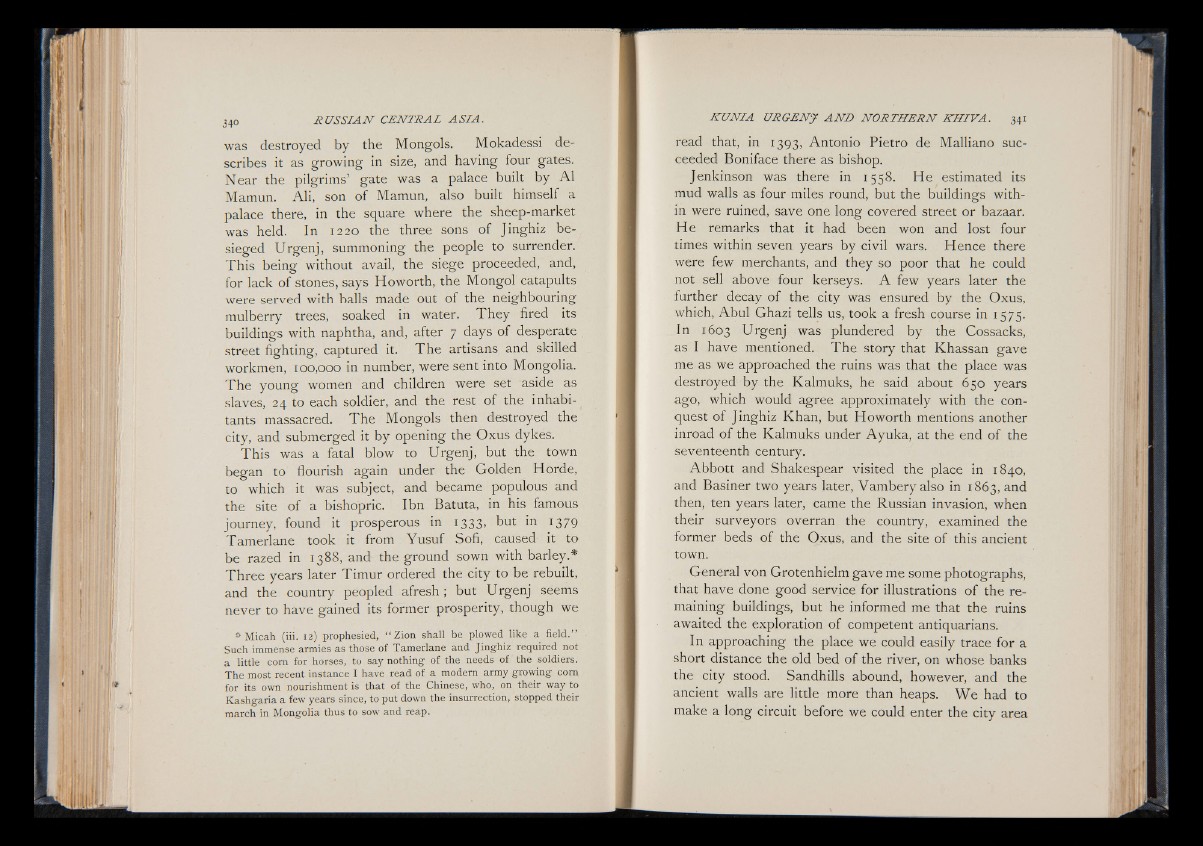
was destroyed by the Mongols. Mokadessi describes
it as growing in size, and having four gates.
Near the pilgrims’ gate was a palace built by A 1
Mamun. Ali, son of Mamun, also built himself a
palace there, in the square where the sheep-market
was held. In 1220 the three sons of Jinghiz besieged
Urgenj, summoning the people to surrender.
This being without avail, the siege proceeded, and,
for lack of stones, says Howorth, the Mongol catapults
were served with balls made out of the neighbouring
mulberry trees, soaked in water. T hey fired its
buildings with naphtha, and, after 7 days of desperate
street fighting, captured it. T he artisans and skilled
workmen, 100,000 in number, were sent into Mongolia.
The young women and children were set aside as
slaves, 24 to each soldier, and the rest of the inhabitants
massacred. The Mongols then destroyed the
city, and submerged it by opening the Oxus dykes.
This was a fatal blow to Urgenj, but the town
began to flourish again under the Golden Horde,
to which it was subject, and became populous and
the site of a bishopric. I bn Batuta, in his famous
journey, found it prosperous in 1333, but in 1379
Tamerlane took it from Yusuf Sofi, caused it to
be razed in 1388, and the ground sown with barley.*
Three years later Timur ordered the city to be rebuilt,
and the country peopled afresh ; but Urgenj seems
never to have gained its former prosperity, though we
* Micah (iii. 12) prophesied, “ Zion shall be plowed like a field.”
Such immense armies as those of Tamerlane and Jinghiz required not
a little com for horses, to say nothing of the needs of the soldiers.
The most recent instance I have read of a modern army growing com
for its own nourishment is that of the Chinese, who, on their way to
Kashgaria a few years since, to put down the insurrection, stopped their
march in Mongolia thus to sow and reap.
read that, in 1393, Antonio Pietro de Malliano succeeded
Boniface there as bishop.
Jenkinson was there in 1558. He estimated its
mud walls as four miles round, but the buildings within
were ruined, save one long covered street or bazaar.
He remarks that it had been won and lost four
times within seven years by civil wars. Hence there
were few merchants, and they so poor that he could
not sell above four kerseys. A few years later the
further decay of the city was ensured by the Oxus,
which, Abul Ghazi tells us, took a fresh course in 1575.
In 1603 Urgenj was plundered by the Cossacks,
as I have mentioned. The story that Khassan gave
me as we approached the ruins was that the place was
destroyed by the Kalmuks, he said about 650 years
ago, which would agree approximately with the conquest
of Jinghiz Khan, but Howorth mentions another
inroad of the Kalmuks under Ayuka, at the end of the
seventeenth century.
Abbott and Shakespear visited the place in 1840,
and Basiner two years later, Vambery also in 1863, and
then, ten years later, came the Russian invasion, when
their surveyors overran the country, examined the
former beds of the Oxus, and the site of this ancient
town.
General von Grotenhielm gave me some photographs,
that have done good service for illustrations of the remaining
buildings, but he informed me that the ruins
awaited the exploration of competent antiquarians.
In approaching the place we could easily trace for a
short distance the old bed of the river, on whose banks
the city stood. Sandhills abound, however, and the
ancient walls are little more than heaps. We had to
make a long circuit before we could enter the city area